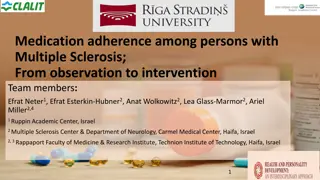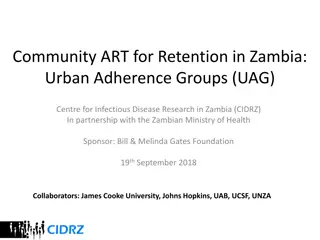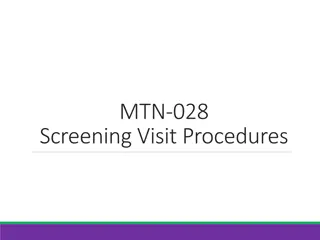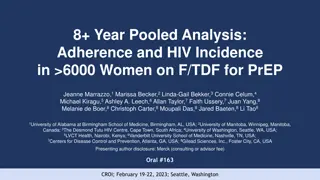Adaptive Tree-based Convergecast Protocol
Adaptive tree-based protocol for managing overlay networks in heterogeneous networks. It proposes improvements to the existing Tree-Based Convergecast Routing (TBCR) protocol by considering additional parameters such as RTT, power consumption, link stability, and link mobility to optimize routing de
32 views • 12 slides
Addressing 5G Signaling Protocol Vulnerabilities
The 8th meeting of the Communications Security, Reliability, and Interoperability Council to discuss and address security vulnerabilities in the newly adopted 5G signaling protocol, HTTP/2. Learn about potential risks, recommended safeguards, and the prevention of these vulnerabilities in the upcomi
3 views • 85 slides
Suicide Prevention & Postvention Protocol
This protocol provides practical advice and support for schools and colleges in Hampshire to navigate the aftermath of a suspected suicide among students or staff members. It includes guidance on interventions, critical incident response, and resources to support the bereaved. Key stages of the post
0 views • 37 slides
Comprehensive ICU Protocol for Sedation, Analgesia, and Delirium Control by Dr. Vinod Srivastava
This comprehensive ICU protocol by Dr. Vinod Srivastava, an Associate Professor in Anaesthesiology & Critical Care at KGMU, covers key aspects such as sedation, analgesia, delirium assessment and control, stress ulcer and deep vein thrombosis prophylaxis, and glycaemic control in the ICU setting. Th
1 views • 50 slides
Important Networking Concepts Overview
Review essential networking concepts including protocol architecture, protocol layers, encapsulation, network abstractions, communication architecture, and TCP/IP protocol suite. Understand the functions of different layers in networking for reliable data transfer and communication efficiency.
3 views • 43 slides
Enhancing Medication Adherence in Multiple Sclerosis Patients
This study explores medication adherence among individuals with Multiple Sclerosis (MS), presenting insights from observation to intervention stages. It delves into the background of MS, adherence, Disease-Modifying Therapies (DMTs), and the challenges faced. The team identifies reasons for non-adhe
0 views • 41 slides
Comprehensive Guide to Stroke Care: SCENS Protocol Overview
This comprehensive guide delves into the SCENS protocol for stroke care, covering learning objectives, reasons for implementation, major stroke types, risk factors, the 8 Ds of stroke care, important time goals, and the FAST assessment process. It emphasizes the importance of early detection, swift
3 views • 20 slides
Understanding OSI Model and TCP/IP Protocol Suite
Explore the concept of layering in data communication, comparing the OSI model and TCP/IP protocol suite. Learn about protocol layers, protocol hierarchies, and the functionality of each layer in these models. Discover the interrelationships between layers and the evolution from OSI to TCP/IP.
5 views • 57 slides
London Homeless Coalition (LHC) Death Communication Protocol
In 2014, the Memorial Committee of the London Homeless Coalition (LHC) established the Death Communication Protocol to acknowledge, share, and address the loss of individuals experiencing homelessness. The protocol aims to inform partnering organizations of confirmed or unconfirmed deaths, support g
0 views • 12 slides
Understanding Mobile Computing and TCP/IP Protocol Suite
Mobile computing is crucial for continuous internet connectivity regardless of physical location. The TCP/IP protocol suite, consisting of Transmission Control Protocol (TCP) and Internet Protocol (IP), forms the backbone of internet infrastructure. IP addressing and mobility challenges are addresse
1 views • 51 slides
Understanding OSI Model and TCP/IP Protocol Suite in Computer Networking
This chapter explores the OSI model and TCP/IP protocol suite, delving into protocol layers, addressing mechanisms, and network components. It highlights the interface between layers, functions of each layer in the OSI model, and compares TCP/IP protocol suite layers with OSI model layers. The discu
0 views • 30 slides
MAAP Protocol Overview in IEEE 1722: Address Acquisition and Message Format
The MAAP (Multicast Address Acquisition Protocol) is defined in IEEE 1722 for time-sensitive applications in bridged local area networks. It involves acquiring multicast addresses through claiming, probing, and defending messages. MAAP enables dynamic allocation of addresses and defending against co
1 views • 8 slides
Evidence-Based Strategies for Treatment Adherence Improvement
Explore evidence-based approaches like Contingency Management to boost treatment adherence in clients dealing with addiction. Learn methods to encourage meeting with clinicians, medication adherence, and abstaining from substances like methamphetamine. Emphasizing long-term benefits, the strategies
0 views • 29 slides
IEEE 802.11-20/1761r1 Ranging Protocol for 11bd
This document outlines the ranging protocol proposed for IEEE 802.11-20/1761r1, focusing on RTT-based ranging leveraging multi-channel operation. By integrating the 11az ranging protocol, it enables flexible and low-overhead application in 11bd for improved accuracy in ITS bands. The protocol includ
1 views • 13 slides
Recommendations for Screening Adherence to Oral Bisphosphonates in Osteoporosis
The International Osteoporosis Foundation and European Calcified Tissue Society Working Group provides recommendations for screening adherence to oral bisphosphonates in osteoporosis. Low adherence to bisphosphonates can lead to reduced efficacy and cost-effectiveness in treating osteoporosis. The w
0 views • 18 slides
Community ART Program for Retention in Zambia: Analysis of Urban Adherence Groups
A study conducted in Zambia evaluated the Community ART for Retention program, analyzing outcomes after 12 months. Key findings include patient retention in care, late drug pick-ups, and implementation outcomes. Factors such as group adherence, patient characteristics, and reasons for group departur
0 views • 15 slides
Understanding EIGRP: A Comprehensive Overview
Enhanced Interior Gateway Routing Protocol (EIGRP) is a dynamic routing protocol providing various advantages to network administrators. It is a classless routing protocol supporting VLSM and is considered an Interior Gateway Protocol (IGP). EIGRP uses advanced distance vector routing and is known f
1 views • 5 slides
Drug Testing Technician Competencies Overview
Knowledge of Drug Testing and Compliance Unit Procedures and Protocol is essential for Drug Testing Technicians. This includes understanding unit structure, check-in procedures, system review processes, escorting and observing defendants, and chain-of-custody procedures. Different levels of competen
0 views • 17 slides
Understanding SFTP Server Functionality with ACS 5.x by Mohammad Azharuddin AAA Team
SFTP (SSH File Transfer Protocol) is a secure network protocol for file access, transfer, and management over reliable data streams. It enhances security by extending the SSH protocol and can be implemented using a reliable 8-bit byte stream protocol. SFTP commands are sent as 4 ASCII letters follow
4 views • 23 slides
Enhanced Family Court Police Disclosure Protocol for 2024
The 2024 Family Court Police Disclosure Protocol addresses key issues identified in the 2013 protocol, emphasizing timely and proportionate requests for material. Changes include a new checklist for the judiciary, guidance notes, and revised processes for litigants in person. The protocol provides c
1 views • 19 slides
Understanding Maternal Avoidant Coping and Medication Adherence in Pediatric Organ Transplant Candidates
Maternal avoidant coping styles may impact medication adherence in pediatric organ transplantation candidates. Challenges in the field include organ shortage, patient non-adherence, and identifying health risk factors for effective organ allocation. Parents' coping behavior factors of stress include
0 views • 14 slides
Essential Elements of Clinical Trial Protocols
Understanding the key components of a clinical trial research protocol is essential for conducting successful studies. This includes identifying session objectives, discussing trial protocol contents, exploring observational study elements, and learning about reporting guidelines. Study objectives f
1 views • 25 slides
Enhancing Adherence and Retention in HIV Care in Tanzania
A pilot study in Tanzania aims to improve adherence to antiretroviral therapy (ART) and retention in care among adults living with HIV. The intervention utilizes social norms and priming techniques to address common challenges like poor adherence, retention issues, and stigma associated with clinic
0 views • 24 slides
Protocol for Preventing SARS-CoV-2 Spread at Dental Department in Korle Bu
This protocol outlines measures to prevent direct and indirect spread of SARS-CoV-2 at a dental department in Korle Bu, Ghana. It includes initial preventive measures like vitamin C distribution, enforcement of routine protocols such as pre-screening, mask-wearing, and disinfection, and the use of p
0 views • 21 slides
Insights on Race and Medication Adherence in EoE Patients
This presentation discusses findings on the relationship between race and medication adherence among Black and Non-Black children with EoE. It highlights differences in symptom severity, access to care issues, and medication nonadherence in the Black patient cohort. The authors assessed adherence th
0 views • 13 slides
Screening Visit Procedures for MTN-028 Study
The MTN-028 study involves comprehensive screening visit procedures, including administrative, counseling, clinical, and laboratory considerations. Elements such as physical exams, HIV testing, pelvic exams, laboratory tests, and informed consent are detailed. Tools for informed consent, long-term s
0 views • 41 slides
Loneliness and ARV Adherence among People Living with HIV in Ontario, Canada
This study investigates the impact of loneliness on antiretroviral medication adherence among individuals living with HIV in Ontario. Utilizing the Ontario HIV Cohort Study, researchers assessed loneliness levels and adherence through questionnaires, finding associations between loneliness severity
0 views • 15 slides
Integrating Pharmacotherapy and Behavioral Therapy for Substance Use Disorders
This presentation by Dr. Roger D. Weiss discusses the integration of pharmacotherapy and behavioral therapy in treating patients with substance use disorders. It emphasizes the goals of behavioral therapy alongside medication treatment, focusing on medication adherence, defining and achieving substa
0 views • 73 slides
Sync HotStuff: Practical Synchronous State Machine Replication
Sync HotStuff is a practical synchronous protocol that tolerates Byzantine replicas and handles weaker synchrony models. It overcomes issues of requiring a large number of rounds and lock-step execution. The protocol ensures safety by committing blocks and guarantees liveness by continuing to commit
0 views • 15 slides
Adherence Support for AGYW on Oral PrEP - Module 5 Overview
This module focuses on monitoring, follow-up, and adherence support for adolescent girls and young women (AGYW) using oral PrEP. It highlights the importance of promoting adherence and retention, addressing challenges, integrating services, and ensuring respectful care. Strategies for supporting AGY
0 views • 20 slides
Advancing Medication Adherence Through Digital Health Solutions
Research initiatives like the NIH-funded trials involving WisePill ID-Cap, MyTPill technologies, and remote monitoring systems aim to enhance medication adherence among substance users. By comparing adherence devices, conducting controlled crossover studies, and utilizing innovative ingestible event
0 views • 21 slides
Long-term Adherence and HIV Incidence in Women on F/TDF for PrEP
Pooled data from 11 F/TDF demonstration projects involving over 6000 cisgender women over eight years examined adherence and HIV incidence. The study aimed to assess the effectiveness of F/TDF for HIV prevention in real-world settings, revealing adherence patterns in a subset of participants. This r
0 views • 16 slides
Understanding Protocol Deviations in Clinical Trials
Protocol deviations are expected occurrences in clinical trials that may arise from site or participant actions. It is crucial for research teams to identify, report, and learn from these deviations to ensure the integrity and safety of the study. Mechanisms for identifying and reporting deviations,
0 views • 16 slides
23rd EMEP TFMM Online Meeting - Gothenburg Protocol Review Group
The 23rd EMEP TFMM online meeting is scheduled for 3-5 May 2022, focusing on the review of the Gothenburg Protocol. The timeline outlines key documents, deadlines, and tasks leading to the final report adoption in September 2022. The meeting will address topics such as urban air quality trends, long
0 views • 7 slides
Understanding OSI Model and TCP/IP Protocol Suite in Computer Networking
This content delves into the OSI model and TCP/IP protocol suite, highlighting the protocol layers, addressing mechanisms, and communication scenarios. It explores the functions of each layer, the interface between layers, and compares the TCP/IP layers with the OSI model. Through examples and illus
0 views • 46 slides
Ethics of Tuberculosis Care: Supporting Adherence and Patient-Centered Approaches
This module emphasizes the ethical importance of promoting adherence to TB treatment, highlighting challenges faced by patients and the need for patient-centered care. Strategies such as Directly Observed Therapy (DOT) are discussed as ethically justifiable ways to improve treatment adherence while
0 views • 17 slides
Seeking a General-Purpose CCSDS Link Layer Protocol: Next-Generation Data Link Protocol (NGDLP)
This document discusses the proposed Universal Frame Format for a next-generation data link protocol, focusing on major questions about transfer frames, Protocol Link Transmission Unit (PLTU), and Universal Transfer Frame Structure. It explores topics such as frame formats, telemetry transfer frames
0 views • 24 slides
NT Awake Proning Protocol for Non-Intubated Patients
This protocol outlines the benefits and procedure for prone positioning in non-intubated patients experiencing mild to moderate hypoxemia. It highlights patient eligibility criteria, equipment required, and considerations for nursing care. The protocol emphasizes improving oxygenation by promoting a
0 views • 11 slides
Effectiveness of Household Leaders in Improving Malaria Chemoprevention Adherence in Cameroon
The EHLIAN project in Cameroon aims to assess the impact of utilizing Household Leaders to enhance adherence to seasonal malaria chemoprevention in the Far North region. The study compares reminder strategies for adherence to SPAQ courses, evaluates community outcomes, and explores the feasibility o
0 views • 14 slides
Evaluation of Adherence to National Guidelines in Paediatric Patients for Surgical Management of OME
Retrospective review of clinical notes revealed that paediatric patients with OME and recurrent AOM generally met the criteria for surgery as per national guidelines (CG60). Compliance with guidelines was satisfactory, with approximately 81% adherence observed among clinicians. Cases of non-adherenc
0 views • 9 slides







































